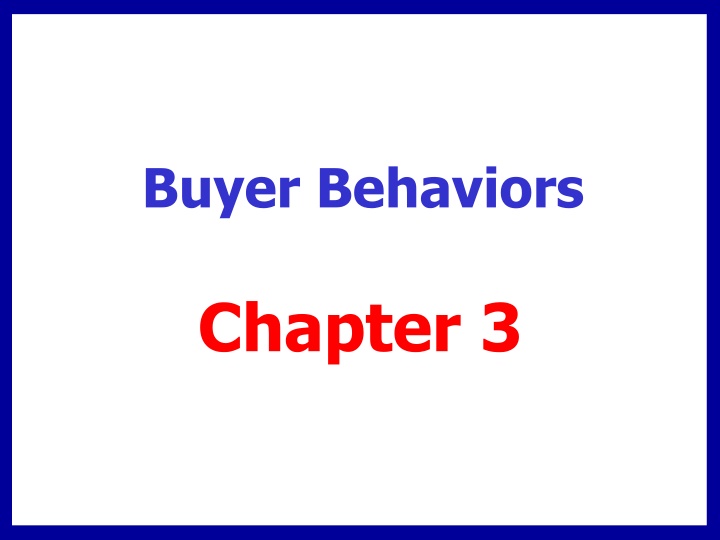
Consumer Behavior and Decision-Making Process
Explore the essential aspects of buyer behaviors, consumer decision-making process, information search, external search factors, consumer values, attitudes, and attitude components. Gain insights into how personal values and attitudes influence purchase decisions, supported by cognitive mapping simulations.
Download Presentation

Please find below an Image/Link to download the presentation.
The content on the website is provided AS IS for your information and personal use only. It may not be sold, licensed, or shared on other websites without obtaining consent from the author. If you encounter any issues during the download, it is possible that the publisher has removed the file from their server.
You are allowed to download the files provided on this website for personal or commercial use, subject to the condition that they are used lawfully. All files are the property of their respective owners.
The content on the website is provided AS IS for your information and personal use only. It may not be sold, licensed, or shared on other websites without obtaining consent from the author.
E N D
Presentation Transcript
Buyer Behaviors Chapter 3
Chapter Overview Chapter Overview Consumer purchase process Consumer buying environment Trends in consumer behavior Business buying center B-to-B purchasing process
Common Purchase Reasons Products/services provide utility To satisfy physical needs To satisfy psychological needs To satisfy social needs To satisfy emotional needs
Consumer Decision-Making Process Fig. 3-1 3-4
Information Search Internal search Known sources Low-risk, low involvement External search Less-frequent purchase Greater social/financial importance
External Search Ability to search Education, pre-existing knowledge Motivation Level of involvement Need for understanding (cognition) Shopping enthusiasm Perceived cost vs. Perceived benefit
Consumer Values Attitudes shaped by personal values. Values are strongly held beliefs. Values contribute to attitudes. Personal values Comfortable life Equality, Freedom Happiness Personal accomplishment
Consumer Attitudes Affective Cognitive Conative Attitudes drive purchase decisions. Marketing communications attempts to influence attitudes.
Attitude 3 Components: Affective Feelings or emotions about the object, topic, or idea. Cognitive Mental images, understanding, interpretations Conative Intentions, actions, behavior
Attitude Sequence Cognitive (Think, feel, do ) Affective Conative Affective (Feel, do, think ) Conative Cognitive Conative (Do, think, feel ) Cognitive Affective
Cognitive Mapping (CM) Simulations of knowledge structures and memories Assumptions, beliefs, interpretations Marketing messages aim to: Strengthen current linkage Modify current linkage Create a new linkage
Principles concerning processing of information and cognitive mapping: CM enhances movement from short- term to long-term memory. Repetition is necessary to establish new linkages. Once linkage exists, difficult to modify or create new linkages.
Role of Marketing Messages in Cognitive Mapping Strengthen linkage Establish a new linkage as alternative to salt Modify linkage Create new linkage Marketing Message Fig. 3-5
Information Processing Elaboration Likelihood Model (ELM) Hedonic, Experiential Model (HEM)
Information Processing Occurs along two routes: Central Route Cognitively processes a message with a high degree of attention to core elements of the message (uses cognitive skills) Peripheral Route Attention paid to marginal cues imbedded in the message (repetition important) Music, actors, background of an ad
ELM HEM Consumers pay attention to Prices Product quality Company/brand attributes Consumers pay attention to Emotions Feelings Fun New or unusual experiences
Evaluation of Alternatives Problem Recognition Information Search Evoked set Evaluation of Alternatives Multiattribute F ig 3 . 6 Affect referral 3-17
Evaluation of Alternatives Evoked set method Evoked set Inept set Inert set Multiattribute method Based on beliefs about a brand s performance on product attributes and the importance of each attribute. (High involvement) Affect referral Chooses brand liked, without evaluation of other brands or attributes
Evoked Set The set of brands and purchase locations that meet both the objective and subjective requirements of the consumer. Development of the evoked set begins during the internal search. Inclusion in the evoked set is a major goal of marketers.
Factors Affecting Consumer Purchasing Behaviors Demographics (age, gender, income, etc.) Heredity and home environment Family life cycle Life changing events Social/Cultural environment Situational environment Unplanned/impulse/variety alternatives
Consumer Trends Age complexity Gender complexity Individualism Active, busy lifestyles Cocooning Pleasure binges Health Emphasis
Postpurchase Evaluation Evaluation of product performance. Cognitive dissonance. Impacts future purchases. Impacts word-of-mouth communications.
Business-to-Business Buyer Behavior A simplistic view of the Buying Center Users Buyers Influencers Deciders Gatekeepers
Traditional BtB Buyer Behavior Process 1. Problem recognition 2. General need description 3. Product specification 4. Supplier/Source search 5. Proposal Solicitation 6. Selection 7. Make the transaction routine 8. Evaluate performance
Creation and Perception of Value Buying Center PERCEIVES Support Activities Total Offering ADDED VALUE Direct Activities CREATES
Individual Factors Business-to-Business Buying Center Personality Roles and perceived roles Motivation Levels of power Attitude towards risk Levels of cognitive involvement Personal objectives Can be summed up as
3 Primary Roles of Buying Center Members Needs of the job function Needs of the organization Personal needs
Types of B-to-B Sales Straight rebuy Modified rebuy New task
Dual/Multiple Channels Based on Customer needs related to economic utility Multi-distribution Multiples of same channel design to reach intended intensity of distribution Dual distribution Unique channel designs for different target markets
Dual Distribution Manufacturer Distributor Large end user Small user/ Retailer Unique channel designs for different target markets
Multi-Distribution Manufacturer Retailer Retailer Retailer Retailer Retailer Multiples of same channel design to reach intended intensity of distribution
